#website directory software
Explore tagged Tumblr posts
Text

Build and Grow with RP-AXIS Website Directory Software
Looking to launch a sleek, functional directory site? RP-AXIS offers trusted website directory software that makes it easy to list, manage, and promote businesses or services online. Whether you're creating a local directory, classifieds site, or membership hub, this solution has everything built in. The software is designed for simplicity and performance. From listing categories and search filters to mobile-friendly design and monetisation tools, you get everything needed to run a successful directory. Users can submit listings, leave reviews, and even pay for upgrades—all within a streamlined interface. Perfect for agencies, startups, or community projects, RP-AXIS gives you complete control. Custom fields, branding options, and feature modules ensure your directory looks and behaves exactly how you want. Why settle for rigid templates? With RP-AXIS’s website directory software, flexibility and user experience come standard.
0 notes
Text
Going to put all this in its own post too by popular request: here's how you make your own website with no understanding of HTML code at all, no software, no backend, absolutely nothing but a text file and image files! First get website server space of your own, like at NEOCITIES. The free version has enough room to host a whole fan page, your art, a simple comic series, whatever! The link I've provided goes to a silly comic that will tell you how to save the page as an html file and make it into a page for your own site. The bare minimum of all you need to do with it is JUST THIS:

Change the titles, text, and image url's to whatever you want them to be, upload your image files and the html file together to your free website (or the same subfolder in that website), and now you have a webpage with those pictures on it. That's it!!!!! .....But if you want to change some more super basic things about it, here's additional tips from the same terrible little guy:

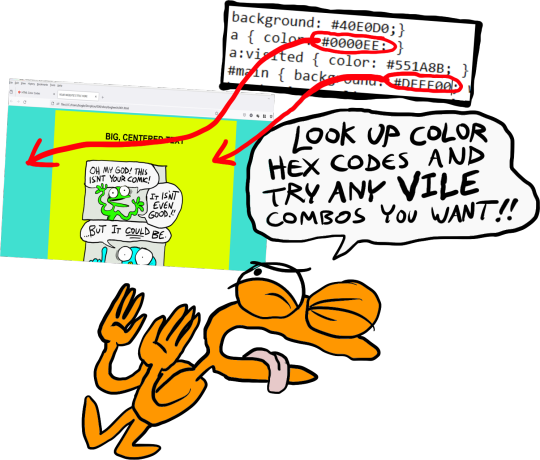
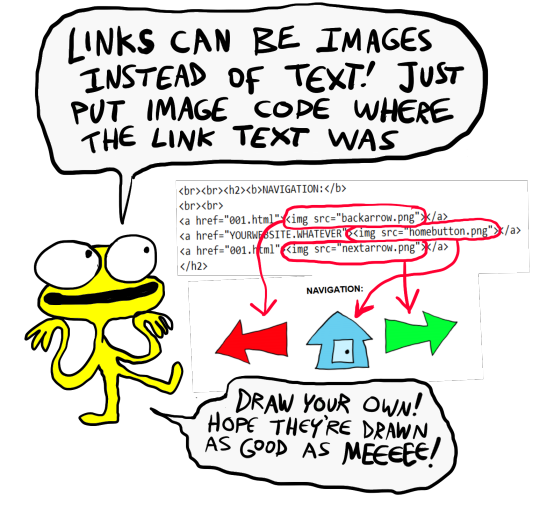
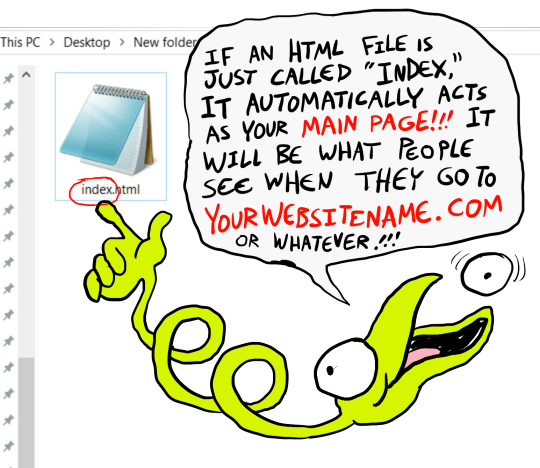

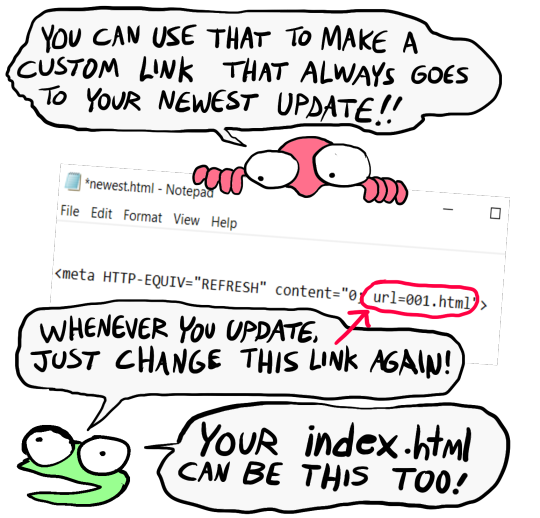
That last code by itself is: <meta HTTP-EQUIV="REFRESH" content="0; url=001.html"> Change "001.html" to wherever you want that link to take people. THIS IS THE REASON WHY when you go to bogleech.com/pokemon/ you are taken instantly to the newest Pokemon review, because the /pokemon/ directory of my website has an "index.html" page with this single line of code. Every pokemon review has its own permanent link, but I change that single line in the index file so it points to the newest page whenever I need it to! While I catered these instructions to updating a webcomic, you can use the same template to make blog type posts, articles or just image galleries. Anything you want! You can delete the navigational links entirely, you can make your site's index.html into a simple list of text links OR fun little image links to your different content, whatever! Your website can be nothing but a big ugly deep fried JPEG of goku with a recipe for potato salad on it, no other content ever, who cares! We did that kind of nonsense all the time in the 1990's and thought it was the pinnacle of comedy!! Maybe it still can be?!?! Or maybe you just want a place to put some artwork and thoughts of yours that doesn't come with the same baggage as big social media? Make a webpage this way and it will look the same in any browser, any operating system for years and years to come, because it's the same kind of basic raw code most of the internet depends upon!
#art#website#websites#resource#resources#webcomics#html#html css#css#neocities#webhosting#old internet#as soon as I drew this shitty scribble guy I uncontrollably interpreted him with Weird Al's voice if you wondered
12K notes
·
View notes
Text
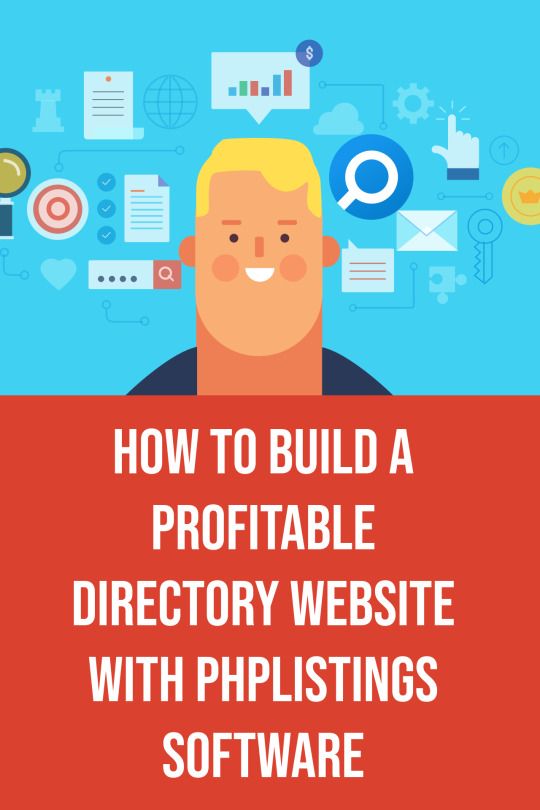
Unlocking Profit Potential: A Professional Approach to Building a Directory Website with phpListings!
Building a lucrative directory website with phpListings demands a strategic and professional approach. In this comprehensive guide, we outline seven crucial steps to ensure your venture's success.
Careful Domain Selection:
The initial step is the choice of an apt domain name that harmonizes with your niche. Prioritize domain relevance, memorability, and the deliberate inclusion of keywords. Additionally, consider the value of an existing domain with a reputable history.
Reliable Hosting:
Secure a robust hosting plan from trustworthy providers like SiteGround, BlueHost, or Dreamhost. phpListings is intricately optimized for seamless operation on shared hosting plans. Ensure compatibility with PHP 8.1 and MySQL or MariaDB.
Expert Installation or DIY:
Benefit from our experienced professionals who are on hand to facilitate the software's installation. Alternatively, utilize our comprehensive installation guide for self-installation.
Comprehensive Directory Setup:
Initiate the directory's foundation by configuring essential settings. Choose from a spectrum of listing types for your directory, encompassing Business Listings, Events, Classifieds, Real Estate Listings, Job Offerings, Blog Postings, and more. Create and categorize listings for each specific type. Establish both free and paid membership plans to cater to a wide audience.
User-Friendly Design:
Craft a visually appealing and user-friendly directory using a widget-based layout. Access an array of pre-built widgets to streamline the design process. Remarkably, no coding skills are required to design an attractive interface.
Strategic Promotion:
Capitalize on phpListings' inherent search engine optimization (SEO) capabilities. Maximize your directory's visibility with the inclusion of an autogenerated sitemap. Utilize schema.org rich snippets to enhance search engine visibility further.
Revenue Generation:
Implement a revenue generation strategy by offering listing membership plans for sale. Explore additional income opportunities by selling advertising space to amplify profitability.
By following these seven steps meticulously, you can elevate your directory website with phpListings to a professional and profit-driven platform, ensuring success in the ever-competitive online space.
#directory website#create business directory#local business directory software#business listings software#yellow pages#yelp
0 notes
Text
Unveiling the Magic of Website Directory Software Themes: Expertly Enhance Your Directory
In the fast-paced digital landscape, where first impressions are crucial, the design of your website directory can make all the difference. To captivate your audience and create a seamless user experience, it's essential to employ the right Website Directory Software Themes. In this comprehensive guide, we'll delve deep into the world of website directory software themes and explore how they can expertly enhance your directory. Let's embark on a journey to discover the potential of these powerful tools.
The Role of Website Directory Software Themes

Website Directory Software Themes play a pivotal role in shaping the visual and functional aspects of your directory. They are the artistic canvas on which your directory's content is presented, affecting everything from layout and color schemes to navigation and overall user experience. Choosing the right theme is a strategic decision that can significantly impact your directory's performance and success.
Aesthetic Appeal and User Engagement
The aesthetic appeal of your website directory is a critical aspect that can't be underestimated. A visually pleasing directory not only attracts users but also keeps them engaged. Website Directory Software Themes offer an array of design options, allowing you to tailor your directory's appearance to match your brand identity and create a user-friendly interface.
Navigational Ease and User Experience
User experience is at the core of a successful website directory. It's vital that users can seamlessly navigate through your directory, finding the information they need quickly and efficiently. The right Website Directory Software Theme can streamline the navigation process, ensuring that users have a positive and productive experience.
Mobile Responsiveness and Adaptability
In an era dominated by smartphones and tablets, mobile responsiveness is non-negotiable. Your website directory must look and function flawlessly on various devices and screen sizes. Expertly chosen Website Directory Software Themes offer mobile-friendly designs, ensuring that your directory remains accessible and functional on all platforms.
SEO Optimization and Performance
A successful directory needs more than just visual appeal and user-friendliness; it must also be optimized for search engines. Website Directory Software Themes, when crafted with SEO in mind, can boost your directory's visibility and performance in search engine rankings.
In conclusion, Website Directory Software Themes are not mere design choices; they are powerful tools that can expertly enhance your directory's aesthetics, user engagement, navigation, adaptability, and performance. When chosen and utilized with care, these themes can be the key to a successful and impactful online presence. Whether you're launching a new directory or looking to revamp an existing one, don't underestimate the transformative power of Website Directory Software Themes.
0 notes
Text
Using Sims2Pack Clean Installer with The Sims 2: Legacy Collection (and Ultimate too!)
Bringing over a simple (and previously documented) tutorial on how to make Sims2Pack Clean Installer work with Sims 2 Legacy and UC. This is just an adapated version of SimsWiki's UC FAQ, so all credit goes to them. If you want a written step-by-step, please go to their website! STEP 1: Download Sims2Pack Clean Installer

Download (and install) Sims2Pack Clean Installer. This tutorial will be covering the installable version, but the NoInstall one probably works the same. STEP 2: Open the Sims2Pack Clean Installer configuration file

You will now go into the directory where you selected and installed Sims2Pack Clean Installer on. By default, it installs on the C:/ drive, so it is probably located at C:\Program Files (x86)\Sims2Pack Clean Installer. That may vary if you changed the directory.
Open the file called "S2PCI.ini". That is the configuration file that we will be altering. PS: You can use your computer's default Notepad for this, but software like Notepad++ can be easier to manage/edit.
STEP 3: Edit your Sims2Pack Clean Installer configuration to detect Sims 2 Legacy/UC

Where it says SaveGamePath="", you will add the directory where your game's Documents folder is in between the "", just like shown in the photo. - For The Sims 2: Legacy Collection, it is usually C:\Users\YourUserName\Documents\EA Games\The Sims 2 Legacy - For The Sims 2: Ultimate Collection, it is usually C:\Users\YourUserName\Documents\EA Games\The Sims 2™ Ultimate Collection
After that, simply save and replace the file. Depending on your computer settings, it might say it is not able to save. If this happens to you, simply save the edited S2PCI.ini on your desktop, then copy and paste the file inside the Sims2Pack Clean Installer folder and replace the original file (and it should always ask for you to replace the original file! check the tips below for clarification). It might ask for administrator permission, just click yes and proceed until the file is replaced with the one you just edited.

TIP: Not sure what your username is? Simple: on your File Explorer, go to Documents > EA Games > The Sims 2 Legacy (or Ultimate Collection) and click the bar. It will show the full path to the folder. Copy that path and follow the rest of this step. TIP 2: Make sure to save it as a .ini file and NOT a .txt one! If you are having difficulties with that, go to File > Save as on Notepad and select "All Files (*)" as file type. Make sure to also name it exactly as S2PCI.ini (it SHOULD ask you to replace the original file, if it did not, something is wrong. Try following the steps again making sure everything was properly followed!)
STEP 4: Install your Custom Content

The last step is to install your custom content. To make sure that Sims2Pack Clean Installer is working properly with the configuration file you edited, make sure that it shows the path written in the file when you press install. It should point to the game's Documents folder like the image above. Now that you showed the program where your Sims 2 Documents folder is, it should auto-detect where to put the files. Ta-da! Your Sims2Pack Clean Installer is done and working. Enjoy your Custom Content and Sims2Pack installing galore all you want <3
#ts2#sims2#ts2legacy#legacycollection#thesims2#the sims 2#the sims 2 legacy#sims 2#sims 2 legacy#ts2cc#sims2cc#s2cc
288 notes
·
View notes
Text

Somewhat long, so list is below the divider!
https://ms-dos5.tumblr.com/ Computer photos, old 3d renders, old PC games.
https://chunkycomputers.tumblr.com/ Pictures of nice chunky computers.
https://wwwtxt.org/about An archive of online writings from the early days of the internet
https://arconinternet.tumblr.com/ Internet archive fun!
https://opendirectories.tumblr.com/ Image directories from around the web.
https://www.tumblr.com/oldguydoesstuff Old arcade machines and computers.
https://webcoreparadise.tumblr.com/ Old internet gifs, pixel arts, photos of old tech, etc
https://gaywebcorenostalgia.tumblr.com/ Old LGBTQ web sites.
https://geocitiesdig.tumblr.com/ Old website art and cool 90s CGI stuff.
https://56k-modem.online/ Photos and screenshots of old computers/operating systems/software.
https://oldwindowsicons.tumblr.com/ Collection of old Windows UI graphics.
https://oldwebsurfing.tumblr.com/ Art and gifs from old web sites.
https://obscuritory.tumblr.com/ Obscure old pc games.
https://www.tumblr.com/oneterabyteofkilobyteage Old Geocities Web Sites.
https://never-obsolete.tumblr.com/ Old tech ads, Operating systems, computer gifs.
https://wirlds.tumblr.com/tagged/worlds.com Worlds.com is an old online game form the 90s that, from the look of it, let people make their own little rooms. Quite nice looking!
https://whatdiditlooklike.mementoweb.org/ See the looks of web sites throughout the years.
https://www.tumblr.com/compactdiscinteractive Screenshots from old cd-rom and multimedia games.
#Krissies blog lists#lists#links#blogs#tumblr#tumblr lists#tumblr links#the blogosphere#computers#microsoft#windows#PC#mac#macintosh#linux#vintage computers#internet#internet history#world wide web#webcore#tech#technology#80s#90s#2000s#web sites#online games#online#geocities#pc games
106 notes
·
View notes
Text
Alright. I'm making this post because I was unpleasantly surprised to find Microsoft had forcibly downloaded an """"ai assistant"""" onto my computer (called Copilot), and because finding a site that actually told me how to kill it for good -- in clear, truly step-by-step terms -- was way harder than it needed to be.
Preface: this is only relevant if you're running Windows 11.
Here is your target:

If you see this logo on your taskbar -- or... have Edge installed on Windows 11 -- you've got Copilot. You can't delete it on its own, Microsoft has integrated it into the OS as best they can. The most you can do is disable it (instructions for which are at the very end of this post).
So... to REALLY get rid of it you need to uninstall Microsoft Edge, because it's a part of/reliant on Edge. A lot of bells and whistles of Windows are also reliant on Edge, like widgets, but I never use those. I use my PC almost exclusively for gaming, and I don't want this slimy "ai" shit on my computer. I use Firefox anyway. Edge can go die as far as I'm concerned.
Here's the actual steps, copy-pasted from a website that took me way too long to find. It also really makes my browser chug for some reason, which is why I'm copy-pasting the whole thing. If you still want to look at the site itself, put it in reader view as fast as you can (link to site).
1.) Open Microsoft Edge, type "edge://settings/help" in the address bar, and then press Enter.
2.) Click "About Microsoft Edge" at the bottom of the left-hand pane. Copy the version number at the top of the screen, under Microsoft Edge.
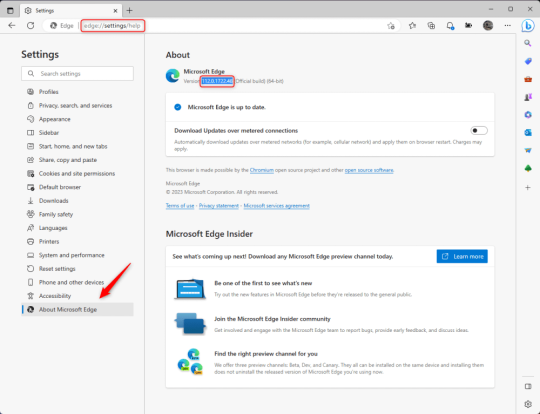
3.) Press Windows Key + S to open Windows Search.
4.) Type "Command Prompt", right-click the result, and then select "Run as Administrator".
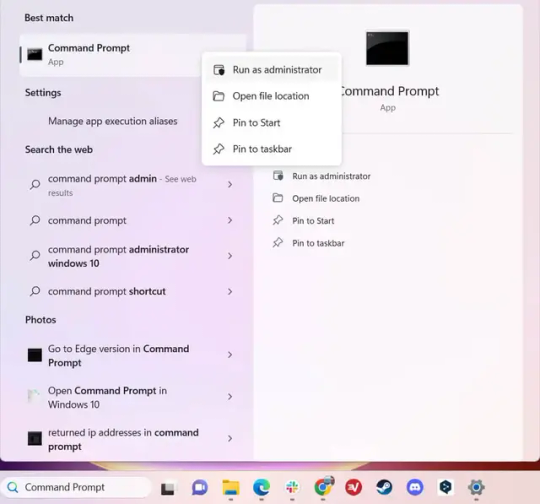
5.) The User Account Control (UAC) prompt will appear. Click "Yes".
6.) Navigate to Edge’s “Installer” directory by using the cd command. Depending on which directory your Command Prompt opens in by default, you may need to use the "cd .." command to go back a level or two.
Once ready, run this command:
cd “Program Files (x86)\Microsoft\Edge\Application\Version Number\Installer”
Replace "Version Number" with your actual version number copied earlier.
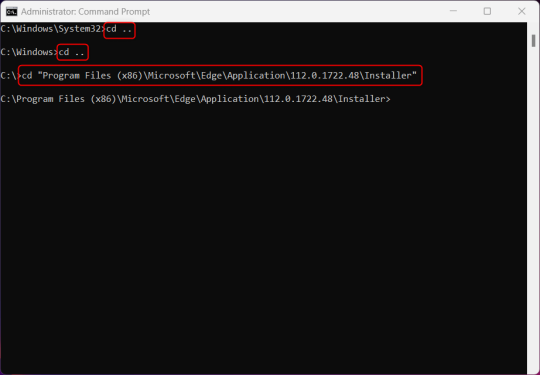
7.) Next, run this command to uninstall Microsoft Edge:
setup –uninstall –force-uninstall –system-level
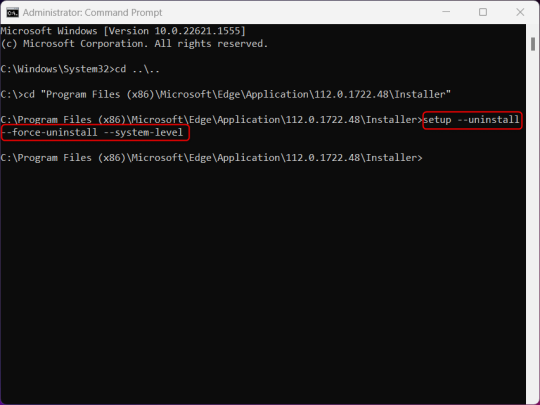
((It will look like nothing happened! Don't worry!))
8.) Restart your PC for the changes to take place.
((HOWEVER, Windows will try to reinstall it the next time your PC updates (or whenever it feels like it lol) so there's a second half to this))
1.) Press Windows Key + R to open Run.
2.) Type "regedit" in the text box and click OK to open the Registry Editor.
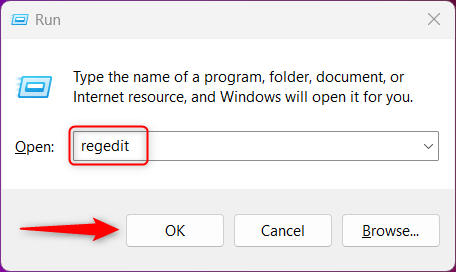
3.) The User Account Control (UAC) prompt will appear. Click "Yes".
4.) In the Registry Editor, navigate to HKEY_LOCAL_MACHINES\SOFTWARE\Microsoft.
5.) Right-click the "Microsoft" folder, hover your cursor over "New", and then select "Key".
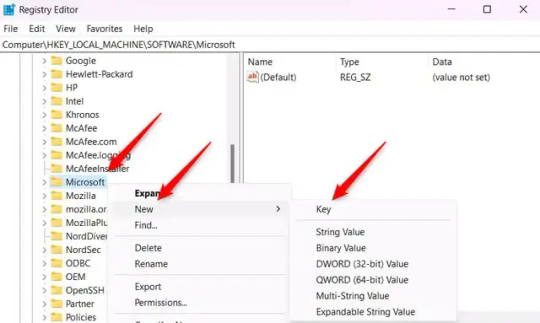
6.) Rename the new Key to "EdgeUpdate".
7.) Right-click EdgeUpdate, hover your cursor over "New", and then select "DWORD (32-bit) Value".
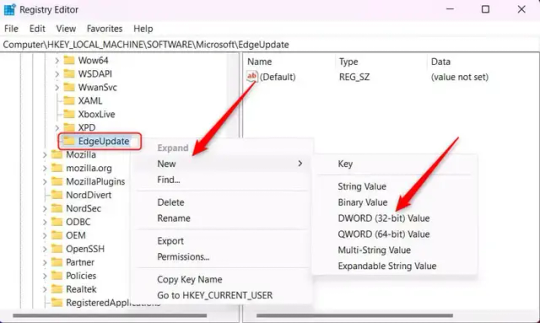
8.) Right-click the new value, which is currently named "New Value #1".
9.) Select "Rename" from the context menu.
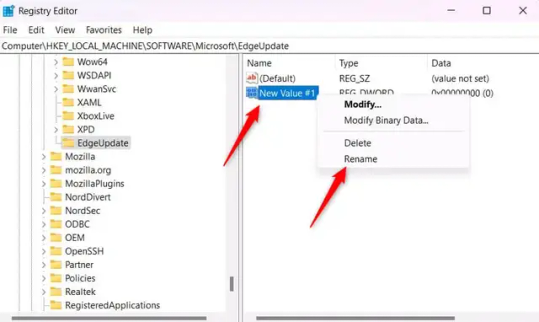
10.) Rename the value to "DoNotUpdateToEdgeWithChromium".
11.) Right-click the newly-named DoNotUpdateToEdgeWithChromium value and select "Modify" from the context menu.
12.) The Edit DWORD (32-bit) Value window will appear. Change the Value data to "1" and then click OK.
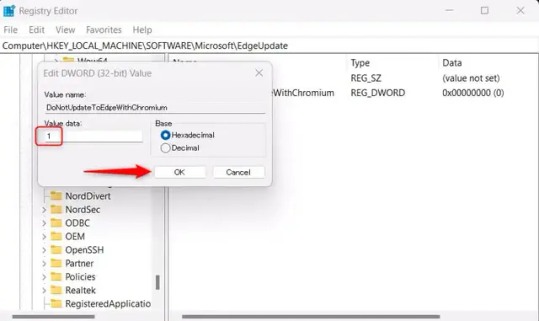
((You are now free. If you ever run into a really serious, unavoidable issue with your OS that's clearly a result of Edge being gone, you can redownload it like a regular app. But you should be fine.))
((And, if for some reason you want still want Edge around but just want the copilot thing gone, here's what you do:
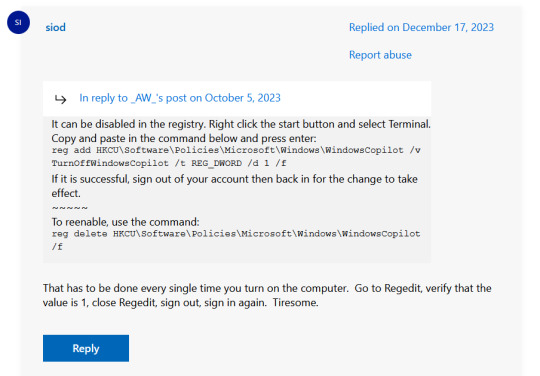
The command, for ease of copy-pasting: reg add HKCU\Software\Policies\Microsoft\Windows\WindowsCopilot /v TurnOffWindowsCopilot /t REG_DWORD /d 1 /f
You can't actually truly delete Copilot (without deleting Edge), only disable it. And as the reply says, you do have to do this every time you turn the computer on. I haven't tested that myself, but I believe it. I assume/hope that excludes just waking the computer up after it goes to sleep, but I don't know for sure.))
120 notes
·
View notes
Text
Top WordPress Plugins to Supercharge Your Website in 2024
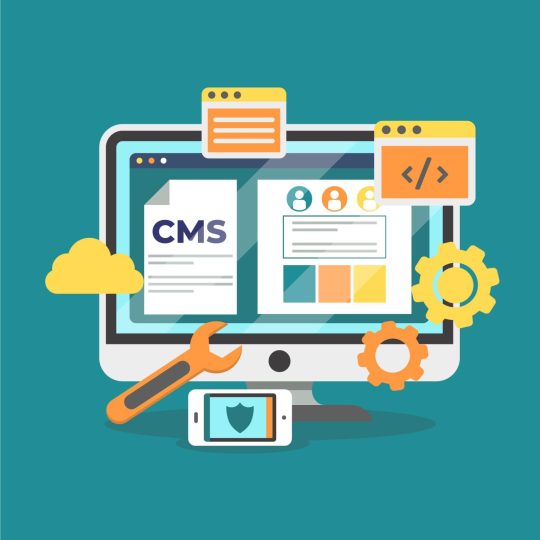
Building and maintaining a WordPress site is both exciting and challenging. While the platform provides a robust foundation, the true power of WordPress lies in its plugins. From enhancing site functionality to improving user experience, WordPress plugins are indispensable tools for developers, businesses, and bloggers alike. In this blog, we’ll explore the best WordPress plugins that can transform your website into a highly functional, user-friendly, and SEO-optimized powerhouse.
What Are WordPress Plugins?
WordPress plugins are software add-ons designed to extend the functionality of your WordPress site. Whether you need to improve site speed, enhance SEO, secure your website, or add unique design features, there’s likely a plugin for that. Plugins allow both beginners and advanced users to customize their sites without coding expertise.
With over 60,000 plugins available on the WordPress Plugin Directory alone, the options can feel overwhelming. Choosing the right plugins for your website’s goals is critical for success. Below, we’ve rounded up some of the most essential WordPress plugins to consider.
Must-Have WordPress Plugins for Every Website
1. Yoast SEO
SEO is crucial for driving organic traffic to your site, and Yoast SEO is one of the best tools for optimizing your content. This plugin provides on-page optimization tips, readability analysis, and technical SEO tools to help your site rank higher on search engines.
2. Elementor
Looking to build a visually stunning website without hiring a designer? Elementor is a drag-and-drop page builder that makes designing websites easy. Its intuitive interface and vast array of widgets allow you to create professional-looking pages in minutes.
3. WPForms
For websites that rely on user interaction, a contact form is a must-have feature. WPForms allows you to create customizable, mobile-responsive forms effortlessly. Whether it’s contact forms, surveys, or payment forms, this plugin has you covered.
4. WooCommerce
If you’re running an online store, WooCommerce is the go-to plugin. It transforms your WordPress site into a fully functional e-commerce platform, complete with features for product listings, payment gateways, and inventory management.
5. Akismet Anti-Spam
Spam comments can clutter your website and ruin user experience. Akismet Anti-Spam automatically filters out spam comments, keeping your site clean and professional.
6. Jetpack
Created by Automattic, the team behind WordPress, Jetpack is a multipurpose plugin offering features like performance optimization, security, site analytics, and social media integration.
7. Rank Math
Another excellent SEO plugin, Rank Math provides advanced features like schema integration, keyword tracking, and detailed analytics. It’s an excellent alternative to Yoast SEO for more advanced users.
8. UpdraftPlus
Backup and restoration are critical for any website. UpdraftPlus allows you to schedule automatic backups and store them securely on cloud services like Google Drive or Dropbox.
9. Smush
Site speed plays a major role in user experience and search engine rankings. Smush compresses images without compromising quality, helping your site load faster.
10. MonsterInsights
Understanding how visitors interact with your site is essential. MonsterInsights integrates Google Analytics directly into your WordPress dashboard, offering real-time insights into traffic, user behavior, and more.
11. W3 Total Cache
Slow-loading websites lose visitors and revenue. W3 Total Cache improves website performance by caching static files and optimizing server resources.
12. Sucuri Security
Cybersecurity is non-negotiable in today’s digital landscape. Sucuri Security offers malware scanning, firewall protection, and blacklist monitoring to keep your site secure.
13. Social Snap
Boost social media engagement with Social Snap, a powerful social sharing plugin. It offers customizable sharing buttons and in-depth analytics to track your social media performance.
14. Litespeed Cache
For websites hosted on LiteSpeed servers, LiteSpeed Cache is a high-performance optimization plugin that enhances speed and reduces server load.
15. TablePress
If your site needs to display complex data, TablePress is a lifesaver. It lets you create and manage tables without requiring any coding knowledge.
Why Use WordPress Plugins?
Enhanced Functionality: WordPress plugins extend the capabilities of your site, making it easier to achieve your goals.
Ease of Use: Many plugins are beginner-friendly and require no technical expertise.
Scalability: Whether you’re running a blog, an e-commerce store, or a portfolio, plugins grow with your needs.
Cost-Effective: Most plugins offer free versions with premium features, making them accessible for all budgets.
Tips for Choosing the Right WordPress Plugins
Identify Your Needs: Start by determining what features your site requires.
Check Reviews and Ratings: Plugins with high ratings and positive reviews are generally more reliable.
Update Frequency: Look for plugins that are updated regularly to ensure compatibility with the latest WordPress version.
Avoid Overloading: Too many plugins can slow down your site. Stick to essential ones.
Final Thoughts
WordPress plugins are the backbone of a successful website. By selecting the right ones, you can enhance your site’s functionality, user experience, and performance. Whether you’re aiming to boost your SEO, secure your site, or create stunning designs, there’s a plugin tailored for your needs.
Experiment with the plugins mentioned above and watch your WordPress site thrive. Remember to regularly review your plugin list and update them to ensure optimal performance.
4 notes
·
View notes
Note
I've also been trying to get on the linux train and I'm so with you re: the lack of beginner's guides, it's actually shocking. Like, stop bickering about what distros are better for beginners, I want to know if switching is gonna wipe my data and thus if I should be more careful with my back-ups 😭 had to jump in the deep end and figure out my meagre knowledge thru fucking osmosis
Still haven't fully made the switch, but trying out different distros (aka types: what people are talking about when they say 'linux mint vs debian vs ubuntu vs gentoo vs arch'. I think there's some differences in software availability but I mostly focused on the layout differences) on a live USB was easy enough. If you look up '[distro] live install', you'll find a page on their website where you can download a file called a live image. Then you download a program called rufus and use it to burn the file to a USB (pretty sure you can reverse the process and use the USB again but I've never done that 🤷♀️). Then if you stick the USB in a USB slot and then power on your computer, it should come up with a menu to test out the distro or run a live image. Then you can play around in it and see what it feels like, though turning off your computer does end the session and reset anything you did in the session. Windows files are still available to use and look at, they're just in a seperate directory, as if on a USB stick in file explorer.
Windows fucked up so I've been living off of a live image of debian for a while, and albeit as a user with pretty low demands (basically just internet + office programs), it's been serving me pretty well.
Sadly it pretty much is a lot of figuring stuff out as you go along (plus a lot of googling things people reference), but since I'm still looking around for a proper guide before I fully commit to linux, I'll send any good ones your way.
thank u for this. i want to not use windows bc fuck microsoft and their military contracts and it's frustrating how horribly inaccessible this is while the users pretend it's easy and simple. someday ill figure it out i guess
3 notes
·
View notes
Text
December 2023 Newsletter – Year in Review
Here is our December Newsletter!
Main event:
As we end 2023, we wanted to take a moment to reflect on our victories for the year. Truly, it has been an incredible ride, with far more success than we could have hoped for.
The rest of the text is under the cut; relevant links are embedded in the text on our website.
Lobbying with the US Senate: We worked with Senator Baldwin’s office to help the COOL Online Act (a bill to crack down on dishonest resellers) pass committee. Read our analysis of the bill here.
Fighting Etsy’s Reserve Payment Policy: Our work, combined with the heroic efforts of UK sellers and the media, pressured Etsy to reduce or lift their devastating payment reserve policy for many sellers. Samantha Vass, a prominent UK seller who spoke out, had her Etsy shop suspended, learn more and support her business here.
Feedback to the FTC: An US Federal Trade Commission lawyer reached out to us for feedback on a new FTC rule against unfair and deceptive business practices around online platform fees. Learn more here.
Presentation to UK Small Business Commissioner: We were able to discuss the issue of online platforms messing with indie sellers’ money in a series of meetings with UK Small Business Commissioner Liz Barclay. Watch a video of the presentation here.
Marketplace Research Project: We had over 1,000 participants in our research survey on what creative indie sellers and their customers want from an online marketplace. Read more about how we will use that data to hold marketplaces accountable here.
In the works:
The first annual ISG virtual convention will be April 13-14, 2024!

We will launch our Marketplace Accreditation Program, unveil our new membership site, and discuss how we can continue to fight the exploitation of creative indie sellers by big tech platforms.
Panels will include:
What to do if you get screwed by a tech platform. – with Katharine from the Electronic Frontier Foundation
Etsy Alternatives: Data and tools to help you find the best marketplaces for your business
How to use your Etsy shop to direct traffic to your own site (without breaking Etsy’s rules) – with Kristi Cassidy, ISG President
Results from our Marketplace Research Project: What do sellers and customers really want from an online marketplace – with Samantha Close, Ph.D.
Interview with Racheal from Mayfli marketplace in the UK
Interview with Jon from goimagine marketplace in the US
Get your ticket now to reserve your spot! Tickets only cost $1 to help cover the costs of the convention.
Share your story!
The FTC is seeking public comment on their proposed “Rule on Unfair or Deceptive Fees”. After our meeting with the FTC, we are excited about the rule because it will also protect creative indie sellers from unfair and deceptive fees from marketplaces. If the rule goes through, we hope to use it to combat Etsy’s forced off-site ads and other unfair practices.
Please take a moment to share your thoughts in a public comment, we want to make sure the perspective of creative indie sellers is represented!
We heard you:
We know that the seller member directory, and members-only parts of the website in general are a bit difficult to navigate. One of our first goals in 2024 is to update our membership with new software and far more features. Stay tuned for information on how to set up your profile on the new site!
What ISG needs right now:
While we’ve managed some amazing things with a very small budget, thanks to our amazing volunteers and open source software, we need more funding for 2024 to continue to grow and advocate on your behalf.
Please consider making a small donation to the Indie Sellers Guild. If half of our members donate just $5, we will raise enough funding for the next 6 months. Or you can buy one of our awesome merch items so you can represent the Guild and show off the work of your fellow artists. The Guild receives $5 from every merch purchase.
Thanks so much for your support!
#etsy alternatives#Etsy sellers#unions#Workers rights#workers cooperative#indie sellers guild#small business
6 notes
·
View notes
Text
So there's this website from when I was a kid, it still exists 23 years later and is fully functional (although its main purpose may not be), and the only reference I can find to it online is either the site itself, Wayback Machine, or people referencing an Eddsworld video.
This is a crime. This website is ART. It genuinely looks like a modern website, and it's a repository (edit: a directory, so much of the software is lost, actually...) of software (edit: and other media that CAN be preserved) that I think has preservational merit.
It's a site for distributing prank software.
Probably gonna see if I can do a full site rip and put it on the Internet Archive at some point tbh.
Edit: On observation, they were not a repository as I remembered but a directory that largely linked out to software hosted elsewhere, so a significant number of their download links are likely broken. I'll do what I can. They did host other things besides software, so I'll still archive it. Sad day, though.
2 notes
·
View notes
Text
How to Start a Podcast: Beginner’s Guide to Getting Started - Social Pilot
Part 1 l Part 2 l Part 3 l Part 4 l Part 5 l Part 6 l Part 7 l Part 8 l Part 9 l Part 10 l Part 11 l Part 12 l Part 13 l Part 14 l Part 15 l Part 16
The seventeenth article Sydney gave me is by Social Pilot, which seems to be a catch all for people who use social media to promote businesses.
Planning Stage
Choose a topic
The article recommends to think if you can talk about the episode happily for over a hundred episodes, and if you'll still be excited in six months or a year.
2. Name
It should relate to your topic and make people click on it.
3. Format
Interview? Solo? Co-hosted? One will suit your show better in the beginning, but you're welcome to change it down the line.
4. Title episodes
You should sum up the main point of the episode here, while at the same time encouraging newcomers to listen.
5. Release schedule and length of episodes
Consistency to your schedule is key- you want to let people depend on your podcast so they can incorporate yours into their routine. In the beginning even more so because you'll have to make some kind of schedule to do everything you have to get done before the episode comes out.
And for the length, have a goal to shoot for without obsessing over it to the second.
6. Art
Keep in mind that this will most likely be the most eye-grabbing thing about your podcast. Your name is just words on a screen, the art will be colored.
7. Intro, outro, music
These are optional, but it tends to elevate your show a bit.
8. Scripts
Word for word, bulleted, or just a written plan will all do. Your show needs to be planned at least a little so it can succeed.
9. Equipment and software
A microphone is necessary, as well as something to record your voice and allow you to edit it later. The article has a few options, so you can check them out.
10. Record
Your plan for the episode will help with this part. Just take a deep breath and talk. If you make a mistake, pause for a few seconds and do the sentence over.
11. Hosting site
You need an RSS feed to submit to directories, so this is where your hosting site comes in. You upload the final audio file to your hosting site, and after you hook it up to directories after your first episode, the directories automatically publish as you upload.
12. Promote
This article recommends a website. This lays out more steps for promotion.
13. Monetization
Sponsorship, affiliates, merchandise, and subscription tiers go under this umbrella.
2 notes
·
View notes
Text
What Is off page SEO?
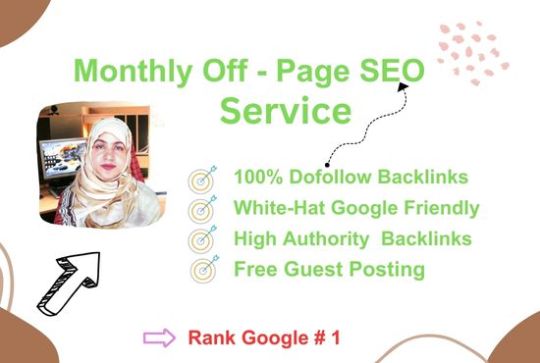
Introduction
Objective: Describe the main goals of your off-page SEO strategy, such as improving website visibility, increasing organic traffic, and building high-quality backlinks.
Competitor Analysis
Competitor Identification: List your main competitors in the industry.
Competitor Backlinks: Analyze their backlink profiles to identify high-authority websites linking to them.
Opportunities: Identify opportunities to acquire similar backlinks or outperform competitors.
Keyword Research
Relevant Keywords: List the primary keywords and phrases related to your business or website.
Long-tail Keywords: Include long-tail keywords that are less competitive but highly relevant.
Keyword Difficulty: Assess the difficulty of ranking for each keyword.
Content Strategy
High-Quality Content: Plan to create valuable, informative, and engaging content.
Content Types: Determine the types of content, such as blog posts, infographics, videos, or guest articles.
Content Calendar: Create a content calendar outlining when and where content will be published.
Content Promotion: Specify how you'll promote your content through social media, email marketing, and outreach.
Link Building
Link Acquisition: Describe your approach to building high-quality backlinks from authoritative websites.
Guest Posting: If applicable, detail your guest posting strategy, including target websites and outreach tactics.
Broken Link Building: Explain how you'll find and reach out to websites with broken links and suggest your content as a replacement.
Influencer Outreach: Outline any plans for collaborating with influencers or industry experts.
Social Media Engagement
Social Media Platforms: List the social media platforms relevant to your audience.
Content Sharing: Plan how you'll share your content and engage with your audience on social media.
Community Building: Describe efforts to build a community around your brand or website.
Local SEO (if applicable)
Local Citations: Ensure consistent NAP (Name, Address, Phone Number) information across online directories.
Google My Business: Optimize your Google My Business profile for local search.
Customer Reviews: Encourage and manage customer reviews on platforms like Google and Yelp.
Monitoring and Reporting
Tools: Specify the tools and software you'll use to monitor your off-page SEO efforts.
KPIs: Define key performance indicators (KPIs) like organic traffic growth, backlink acquisition, and keyword rankings.
Reporting Frequency: Determine how often you'll generate and review reports.
Budget and Resources
Budget Allocation: Allocate a budget for various off-page SEO activities, including content creation, outreach, and tools.
Resource Allocation: Identify team members responsible for each task and their roles.
Timeline
Project Timeline: Create a timeline with milestones for each phase of your off-page SEO strategy.
Ongoing Efforts: Highlight ongoing activities such as content creation, link building, and social media engagement.
Risk Management
Risk Assessment: Identify potential risks and challenges in your off-page SEO strategy.
Mitigation Plans: Develop plans to address these risks if they arise.
Conclusion
Summary: Recap the main points of your off-page SEO strategy.
Next Steps: Outline the immediate next steps and actions to kick-start the strategy.
#off page seo#seo services#seo#backlinks#off page optimization#digital marketing#seo marketing#digitalmarketing
6 notes
·
View notes
Text
Learn about negative SEO tactics and how to protect your website from malicious actions
In today’s highly competitive online landscape, businesses and website owners face not only the challenge of optimizing their websites for search engines but also the threat of negative SEO tactics. Negative SEO refers to the practice of using unethical and malicious strategies to harm a competitor’s website’s search engine rankings and online reputation. This dark side of search engine optimization can lead to devastating consequences for innocent website owners.
In this article, we will explore various negative SEO tactics and provide valuable insights on how to safeguard your website from such attacks.
Link Spamming and Manipulation
One of the most common negative SEO tactics is the mass creation of low-quality, spammy backlinks pointing to a targeted website. These malicious backlinks can lead search engines to believe that the website is engaging in link schemes, resulting in penalties and ranking drops. Website owners must regularly monitor their backlink profiles to identify and disavow any toxic links.
Content Scraping and Duplication
Content scraping involves copying content from a target website and republishing it on multiple other sites without permission. This can lead to duplicate content issues, harming the original website’s search rankings. Regularly monitoring your content for plagiarism and submitting DMCA takedown requests can help address this problem.
Fake Negative Reviews
Negative SEO attackers may leave fake negative reviews on review sites and business directories to damage a website’s reputation. Monitoring and responding to reviews promptly can help mitigate the impact of such attacks.
Distributed Denial of Service (DDoS) Attacks
DDoS attacks overload a website’s server with an excessive amount of traffic, causing it to become slow or crash. Implementing DDoS protection services can help safeguard your website against such attacks.
Regularly Monitor Backlinks
Use tools like Google Search Console and third-party SEO software to monitor your website’s backlink profile. Regularly review and disavow toxic links to prevent negative SEO attacks based on link spamming.
Secure Your Website
Ensure your website is secure with HTTPS encryption and robust security measures. This will help protect your website from hacking attempts and potential negative SEO attacks like content manipulation.
Frequently Check for Duplicate Content
Use plagiarism checker tools to identify if your content has been copied elsewhere. If you find duplicate content, reach out to the website owners to request removal or use the Google DMCA process.
Implement Review Monitoring
Keep an eye on reviews and mentions of your brand across various platforms. Respond professionally to negative reviews and report fake reviews to the respective platforms for removal.
Optimize Website Performance
A fast-loading website can better withstand DDoS attacks. Optimize your website’s performance by compressing images, using caching, and leveraging Content Delivery Networks (CDNs).
Regularly Backup Your Website
Frequent website backups will ensure that even if an attack occurs, you can quickly restore your website to its previous state without losing valuable data.
Use Webmaster Tools and Analytics
Stay vigilant by setting up alerts in Google Webmaster Tools and Google Analytics. These alerts can notify you of sudden drops in website traffic or other suspicious activities.
Conclusion
As the digital landscape continues to evolve, negative SEO tactics remain a persistent threat. Understanding these malicious strategies and proactively taking steps to protect your website is crucial for every website owner.
Discover countermeasures against negative SEO tactics, safeguarding your site from harm. Shield your website with insights from an experienced SEO company in Chandigarh for robust defense strategies.
2 notes
·
View notes
Text
Decoding SEO vs Local SEO for Marketers
Search Engine Optimization (SEO) has become an essential marketing strategy for businesses aiming to improve their online presence. However, not all SEO strategies are created equal. General SEO and Local SEO target different audiences, goals, and tactics. For marketers, understanding the difference between the two is crucial for designing campaigns that truly deliver.
We will decode SEO vs Local SEO, exploring what each entails, how they differ, and why both matter in today’s digital marketing landscape.

What is SEO? An Overview
SEO, or Search Engine Optimization, is the practice of improving a website’s visibility on search engines like Google, Bing, and Yahoo. The goal is to attract organic traffic by ranking higher on search engine results pages (SERPs). SEO encompasses a wide range of activities including keyword research, content creation, on-page optimization (like meta tags and headers), technical SEO, and backlink building. It’s a holistic approach designed to enhance a website’s authority and relevance across broad topics or industries.
Marketers use SEO to reach national or global audiences, driving traffic regardless of physical location. For example, an online software company targeting users worldwide will focus on general SEO to maximize reach and sales.
Understanding Local SEO
Local SEO focuses on optimizing a website to rank well for searches tied to a specific geographic location. This is vital for businesses that serve customers in particular cities, towns, or neighborhoods, like restaurants, salons, or law firms. Local SEO strategies include optimizing Google My Business profiles, acquiring local citations, generating reviews, and embedding local keywords (e.g., “best pizza in Chicago”). The goal is to show up in the “Local Pack” or map listings that appear for geo-specific queries.
For marketers, local SEO means tailoring campaigns to connect businesses with nearby customers actively seeking local products or services. It’s about visibility in proximity-driven searches, often leading to higher conversion rates due to immediate relevance.
Key Differences in Keyword Strategy
SEO and local SEO differ substantially in keyword focus. Traditional SEO often targets broad, high-volume keywords (like “running shoes”) aimed at a wide audience.
Local SEO keywords are more specific and include geographic modifiers—think “running shoes near me” or “running shoes in Denver.” These keywords reflect a searcher’s intent to find nearby options and often include “near me” or city names. Marketers must understand that local SEO requires in-depth research into local search habits and incorporating local language nuances. Tools like Google’s Keyword Planner and Moz’s Local Keyword Finder can help uncover these location-based queries to drive relevant traffic.
On-Page Optimization Differences
On-page SEO involves optimizing content and HTML source code. For general SEO, this means targeting broad topics with keywords sprinkled naturally across pages, creating high-quality content, and ensuring excellent user experience. Local SEO on-page efforts go further by including NAP (Name, Address, Phone number) consistency, embedding maps, and adding localized schema markup. Titles and meta descriptions often include location names to increase relevance in local searches.
Marketers should focus on creating content that answers local questions, includes events, or features local landmarks to build trust with the community and improve local rankings.
Importance of Google My Business and Local Citations
Google My Business (GMB) is a cornerstone of local SEO, allowing businesses to manage their online presence on Google Maps and search results. An optimized GMB profile with accurate information, photos, posts, and regular reviews can dramatically boost local visibility. Local citations—mentions of your business’s NAP on other websites, directories, and social platforms—further validate your business’s existence and trustworthiness to search engines.
While general SEO focuses more on backlinks and domain authority, local SEO relies heavily on these local signals to rank well in localized search results. Marketers should prioritize GMB optimization and citation building as part of local SEO campaigns.
The Role of Reviews and Reputation Management
Customer reviews play an outsized role in local SEO. Positive reviews not only build consumer trust but also influence search engine rankings. Google considers review quantity, quality, and recency when ranking local businesses. For marketers, managing online reputation is critical—encouraging satisfied customers to leave reviews, responding promptly to feedback, and addressing negative comments professionally.
In general SEO, reviews may matter less directly but can still impact brand perception and conversion rates. Local SEO elevates reviews as a key trust factor that helps drive foot traffic and leads.
Measuring Success: SEO vs Local SEO Metrics
Both SEO and local SEO require monitoring, but the key performance indicators (KPIs) can differ. General SEO focuses on organic traffic, keyword rankings, backlinks, and domain authority. Local SEO metrics often emphasize visibility in the Local Pack, number of map views, clicks to call, driving directions requests, and local website visits.
Marketers should use tools like Google Analytics, Google Search Console, and GMB Insights to track these KPIs and adjust strategies accordingly to maximize ROI for both SEO types.
Conclusion: Why Marketers Need Both Strategies
SEO and local SEO are not mutually exclusive—they complement each other. For businesses aiming for wide-reaching national exposure, general SEO is essential. Meanwhile, local SEO ensures those businesses capture attention from nearby, ready-to-buy customers.
youtube
Marketers must understand the unique tactics, tools, and goals behind each to craft effective, integrated campaigns. In an increasingly competitive digital environment, leveraging both SEO and local SEO strategies enables brands to connect with audiences at every stage—from broad awareness to local conversion.
Mastering the nuances between SEO and local SEO empowers marketers to deliver relevant content, increase visibility, and drive growth—no matter where their customers are searching from.
0 notes
Text
How To Start A Freight Forwarding Business? 10 Easy Steps
Thinking about how to start a freight forwarding business? Here’s a simplified guide to get you moving in the right direction:
Choose Your Business Structure Pick between LLC, sole proprietorship, or corporation.
Register Your Business & Get an EIN File with your state and apply for an EIN from the IRS.
Obtain Necessary Licenses Apply for a freight forwarder license (FMC) and register with CBP.
Set Up Bonds and Insurance Get a freight broker bond and cargo liability insurance.
Get a SCAC Code Secure a Standard Carrier Alpha Code to identify your company.
Set Up a Business Bank Account Keep your business finances organized and separate from personal funds.
Build Carrier Relationships Partner with trucking, air, and ocean carriers to offer flexible options.
Use Freight Forwarding Software Automate quoting, tracking, customs paperwork, and invoicing.
Comply with U.S. Regulations Follow FMC, DOT, and CBP guidelines to stay compliant.
Start Marketing Your Services Build a website, use digital ads, and list on logistics directories.
Knowing how to start a freight forwarding business sets the foundation for long-term success in global trade.

0 notes